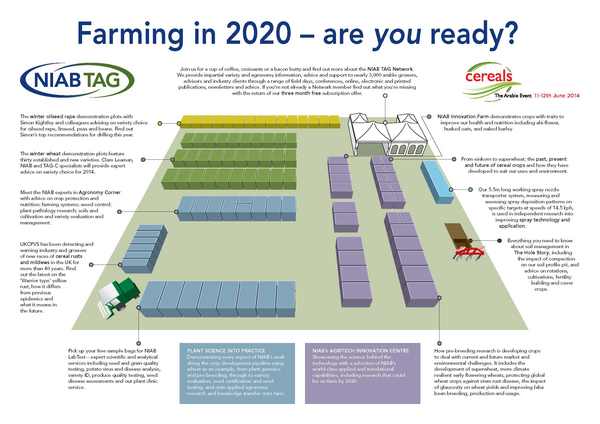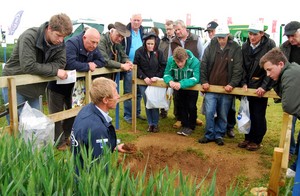FARMING IN 2020 - are you ready?
Stand summary
The latest independent advice and research on plant breeding, varieties, crop agronomy, soils and plant innovation – covering everything a visitor to Cereals 2014 is looking for, including:
- Winter wheat and winter oilseed rape variety demonstration plots
- NIAB’s AgriTech Innovation Centre with the science behind the technology
- From einkorn to superwheat; the past, present and future of cereal crops
- Demonstrating spray deposition patterns with our spray nozzle transporter system
- NIAB Innovation Farm using crops to improve health and nutrition
- Independent agronomy research and advice
- ARTIS – a new technical agricultural and horticultural industry training initiative
- The Hole Story with advice on soil management, rotations, cultivations, fertility building and cover crops
With the renewed emphasis on research and innovation at the farm-level NIAB TAG is at Cereals 2014 with some of the improvements in crop genetics and agronomy and latest advances in precision engineering and agricultural informatics that could be on farm by 2020.
“Under our ‘Farming in 2020 –are you ready?’ banner we’re addressing issues such as pesticide resistance, yield plateau, loss of triazoles, new disease races, changes in EU legislation and climate change. Our stand will demonstrate solutions that are already on-farm or in the pipeline, including superwheat, new research into soils, rotations and cultivations, new crops, precision farming options, and advances in pre-breeding research,” explains Bill Clark, NIAB’s Technical Commercial Director.
“We have more plots than ever before – 97 of them – mainly winter wheat, but we also have winter oilseed rape, faba beans, spring barley, oats, ahi flower, rye, tritordeum, goatgrass, triticale and durum wheat. This has been helped by our slightly larger exhibit area than the past few years.”
NIAB’s AgriTech Innovation Centre has the science behind the technology with a selection of world-class applied and translational research. NIAB’s pre-breeding research is developing crops to deal with current and future market and environmental challenges, include the development of superwheat, more climate resilient early flowering wheats, protecting global wheat crops against stem rust disease, the impact of glaucosity on wheat yields and improving faba bean breeding, production and usage.
“There has been significant interest over the past 12 months in our synthetic wheat, now known as superwheat, project,” says Bill. “This year each step of the superwheat crossing programme is on view, as well as some of the new lines aiming to bring new genetic diversity into modern plant breeding programmes including better disease resistance, drought tolerance and higher yields. This is supported by plots showing the past, present and future of cereal crops and how they have developed to suit our uses and environment where we will be challenging growers to identify the cereal crop.”
Visitors will also be able to view a working 5.5m long working spray nozzle transporter system used in independent research into improving spray technology and application. Andy Lane will show how the system, usually found in the wind tunnel at NIAB TAG’s Silsoe Spray Applications Unit, measures and assesses spray deposition patterns on specific targets at speeds of 14.5 kph.
Soils and varieties
The Hole Story returns for its third year, with a few additions to the soil pit for specialists Nathan Morris, Ron Stobart and Mark Stalham. Visitors will be able to see the impact of winter compaction on the soil profile alongside a fodder radish cover crop. A subsoiler will also be pulled through the soil as a backdrop to NIAB TAG’s research findings on cultivations and rotations.
“We’re hoping the compaction, even on this chalky soil, will help us explain how a well structured soil can help water infiltration and aid moisture retention. We will discuss how we can increase soil aeration for root growth and biological function and improve the workability of the soil,” says Nathan.
The demonstration plots include 15 winter oilseed rape varieties with Simon Kightley advising on variety choice for oilseed rape, linseed, peas and beans, and Clare Leaman providing expert advice on winter wheat variety choice for 2014 with thirty established and new varieties. Simon and Clare will be supported on the variety demonstration plots by other NIAB and TAG-C specialists.
The Plant Science into Practice exhibit demonstrates every aspect of NIAB’s work along the crop development pipeline using wheat as an example, from plant genetics and pre-breeding, through to variety evaluation, seed certification and seed testing, and onto applied agronomy research and knowledge transfer onto farm.
“As part of the Plant Science into Practice exhibit our agronomy plots this year include disease management, row-width and seed rate research, rotations, black-grass control and yield management with the return of the New Zealand variety Wakanui versus the UK variety Conqueror,” finishes Bill.
Other features available on the NIAB TAG stand include:
- Introducing ARTIS – an industry led technical training programme for arable, salad, vegetable and fruit farmers and growers in England, delivered by NIAB, G’s Growers, LANTRA and East Malling Research;
- Pick up free sample bags for NIAB LabTest - expert scientific and analytical services for farmers, agronomists and trade, including seed and grain quality testing, potato virus and disease analysis, variety ID, produce quality testing, seed disease assessments and our plant clinic service.
- Variety evaluation and testing services – explaining the background behind the statutory DUS (Distinctness, Uniformity and Stability) and VCU (Value for Cultivation and Use) variety testing carried out by NIAB specialists;
- NIAB TAG Network membership services – sign up for three months free access to the top of the range Agronomy membership including field days, trials results, unique regional variety information and weekly agronomy updates through the season;
- UKCPVS (UK Cereal Pathogen Virulence Survey) has been detecting and warning industry and growers of new races of cereal rusts and mildews in the UK for more than 40 years, with six plots showcasing the history of yellow rust race development. Find out the latest on the ‘Warrior type’ yellow rust and how it differs from previous epidemics from Amelia Hubbard and Dr Emma Coventry.


